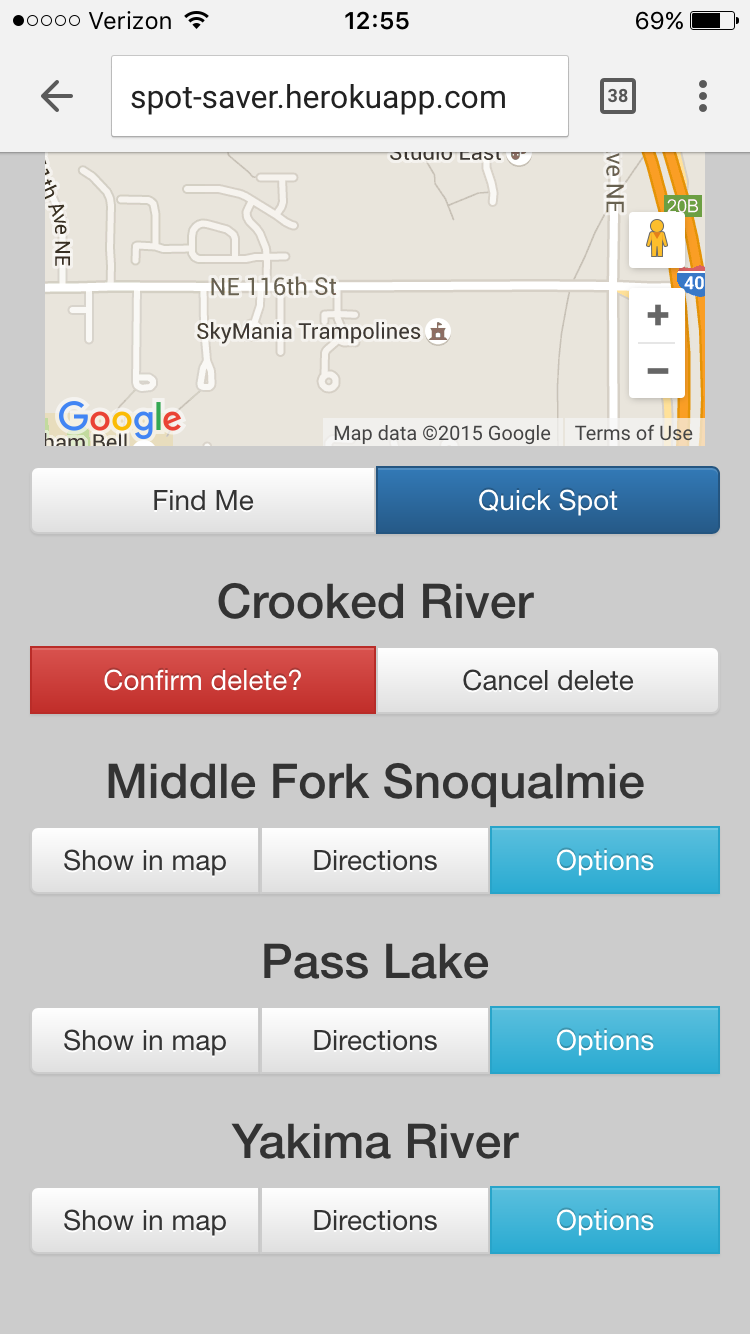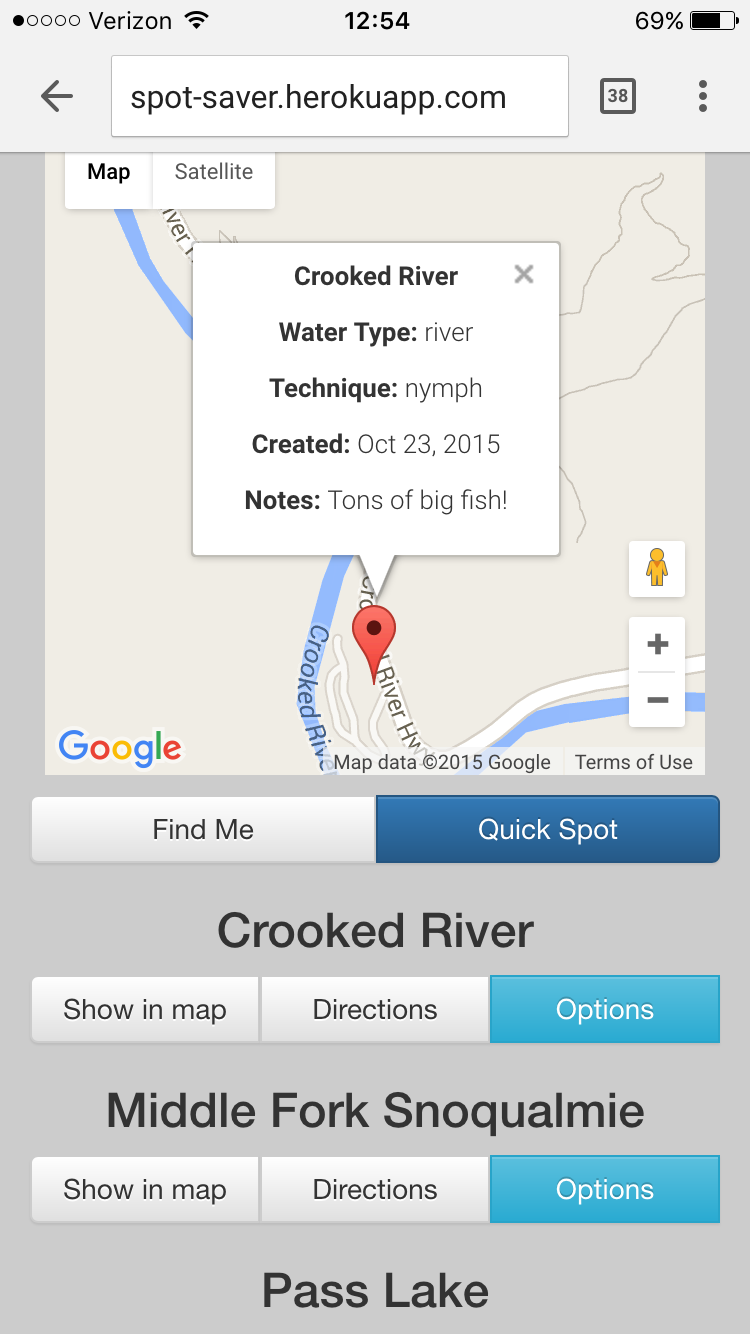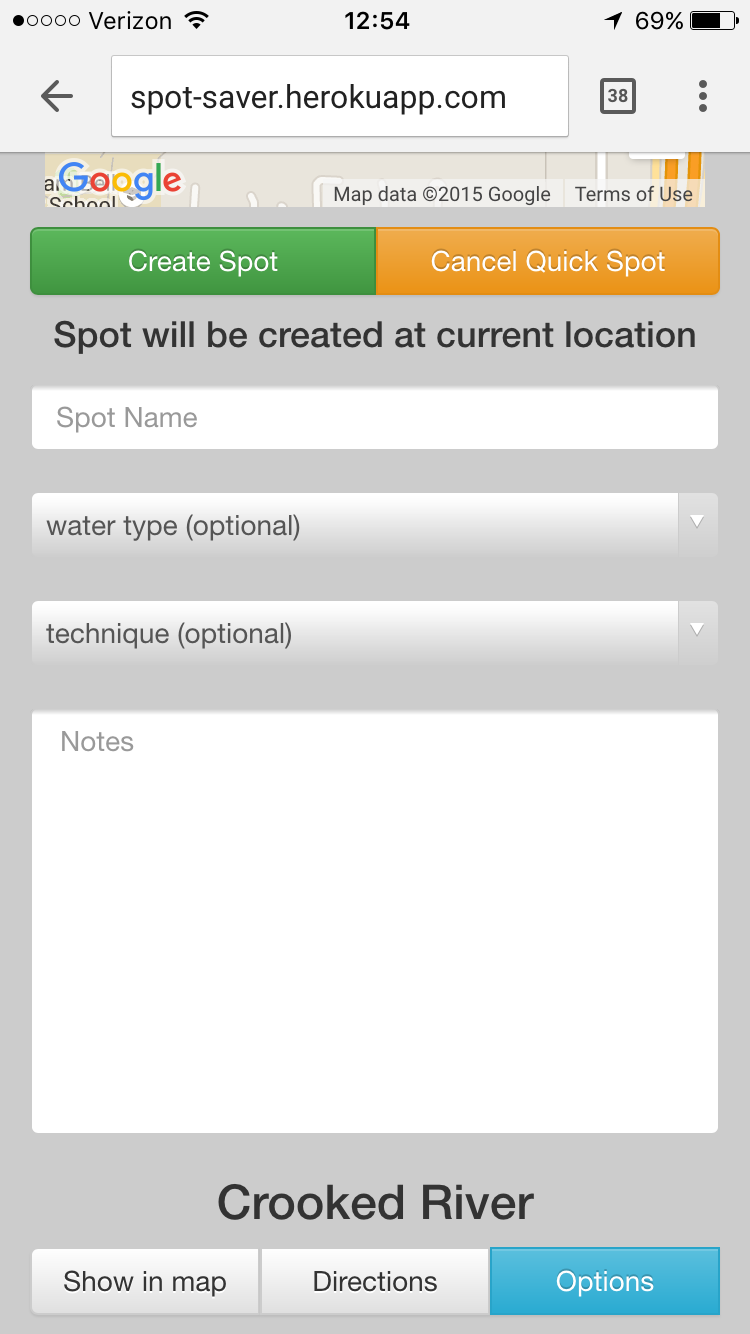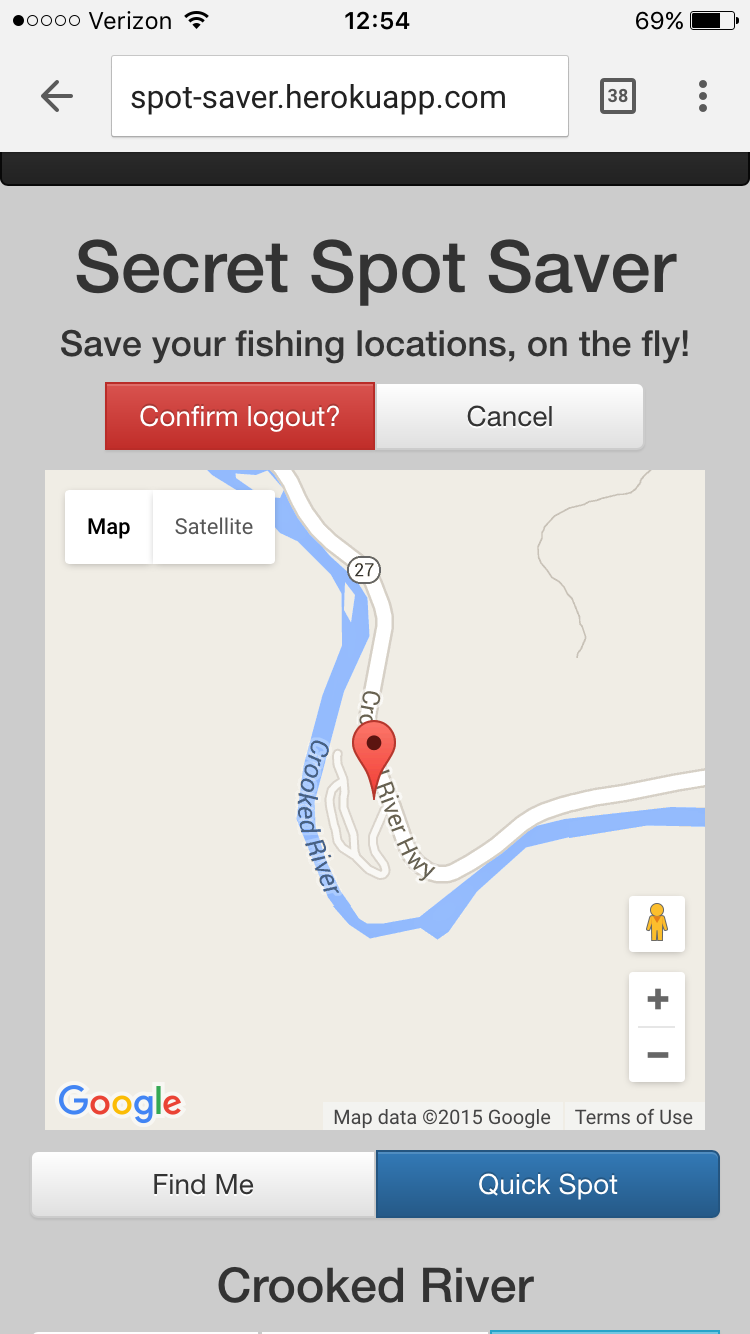Secret Spot Saver | Save your fishing locations, on the fly!
A web app to keep all of your favorite fishing spots secret and secure. See nearby locations and get directions via Google Maps integration.
The app can be accessed here: https://spot-saver.herokuapp.com
by Matthew Yang
Description
The objective of this single page application is to be able to save information about a fishing spot including latitude/longitude, water type, fishing technique and notes. These locations are kept secure using an authentication and authorization system that only allows a registered user to see his/her own created spots.
Additionally the web interface was designed using AngularJS to be a quick single page application that utilizes AJAX calls to a Rails API and dynamic HTML to prevent full page refreshes.
Technology Used
At the most basic, this application utilizes a Ruby on Rails back-end as an API for an Angular.JS front end, single page application.
However there is a lot of other technology incorporated to make this work (relatively) smoothly.
Rails
I started by generating a new Rails application and modeling my resource, which I called a Spot. This spot would contain all the information of a location:
- Name
- Latitude
- Longitude
- Water type
- Technique
- Notes
I then generated a SpotsController and started creating the CRUD actions. However because I knew this would be accessed as an API I made sure that instead or rendering views I returned a JSON object. Fortunately Rails makes this incredibly simple by allowing you to write a statment like render json: spot, which will convert an ActiveRecord object to JSON and package it up into a response.
NOTE: I considered using an API versioning strategy, however with limited time to get this up and running I left that as a future refactor.
Active Model Serializers
I then utilized the Active Model Serializers gem, which allows you to format your JSON objects to your liking, returning only the information you specify and in the format you decide.
# app/serializers/spot_serializer.rb
class SpotsSerializer < ActiveModel::Serializer
attributes :id,
:user_id,
:name,
:lat,
:lon,
:water_type,
:technique,
:notes,
:created_at,
:updated_at
endAngular.JS
With the API tested and passing, I moved on to the web interface of the application. Modeling after some of my previous projects, I decided to have the Angular.JS application live in the app/assets folder in Rails and utilize the Rails Asset Pipeline to serve it.
I generated a simple controller called landing whose index view would serve as the base of the application and set it to the root path.
I then started outlining an HTML framework based on some UI design drawings I had sketched up earlier. In order to minimize page refreshes and take advantage of Angular's client side MVC efficiency, I incorporated a number of ng-hide and ng-show in order to make the page feel dynamic without having to actually refresh any HTML.
For the JavaScript, I created controllers for the major actions which incorporate AJAX requests to the Rails API:
- Sign in
- Sessions
- Spots
I was able to create a welcome/sign in page, sign up page and a main application page that dynamically changes for spot addition/deletion/edit.
Devise / Angular Devise
Devise on the Rails side is very straightforward and smooth when following the directions in the README and I had it up and running within an hour.
As far as integrating Devise (current user, user sessions, authentication) into Angular, luckily I had recently accomplished this in a previous project.
I installed the Angular Devise JavaScript library and incorporated a strategy of a now-defunct blog post to set up a sign in controller and a session controller.
Pundit
I incorporated the Pundit gem for authorization and developed a simple spot policy which is stored in app/policies. Through simple integration in the controllers, you can verify that only authorized information is returned during an AJAX request:
# index action from app/controllers/spots_controller.rb
def index
spots = policy_scope(Spot)
render json: spots, status: 200
endAngular Google Maps
I used the following JS library called Angular Google Maps in order to incorporate maps into my application. The documentation is fairly easy to follow for basic operations, however it took a lot of trial and error to get more advanced features working.
Eventually I was able to get the map to appear and show previously created spots as well as create a new spot given the user's current location by utilizing the HTML5 navigator.geolocation JS object API of modern web browsers.
This information was then successfully saved via the API and redisplayed via AJAX calls.
NOTE: As of this writing, one of the main features I planned during design of being able to add a spot location after the fact (not current location) is not working. After spending almost a full day trying to get it working I decided to move on, especially since the core of the this application was created in a 4 day time-frame.
Angular Flash
Flash messages have been incorporated using Angular Flash.
Here's an example of the JavaScript for displaying an error message:
...
}, function(error){
$.each(error.data.errors, function(index, value) {
errorMsg += (index + ' ' + value + ': ');
})
flash.to('signup-alert').error = errorMsg;
});Angular Rails CSRF
In order to access the built in Angular Cross Site Request Forgery I added the Angular Rails CSRF gem that will send the token in a header.
One obstacle that I again had encountered in a previous Rails/Angular application was an issue with the CSRF token being invalidated after a Devise log in. See my blog post about this for more information on the work-around.
NGAnnotate Rails
When serving Angular code from a Rails application using the Rails Asset Pipeline, you run into issues when the code is minified. In order to get around this I installed the NGAnnotate Rails gem, which is a gem version of NG Annotate.
Background Jobs (Sidekiq/Redis/Sendgrid)
ActionMailer has been configured along with Sidekiq (which uses Redis) and Sendgrid on Heroku to send a welcome email to new users on successful registration. It also sends a notification email to myself advising of a new registration.
This is done in a background job by creating a Sidekiq worker and calling that worker to execute asynchronously after yielding to super in the registrations_controller.rb that was generated from devise.
I also followed these instructions to use the Unicorn server on Heroku and generate workers within the same dyno (therefore free) instead of requiring a second dyno.
Styling
For this project I incorporated Bootstrap in order to make it mobile focused with large buttons and layout.
Testing
I committed to have a full test suite for the entire application. Current test coverage via Coveralls:
Integration testing for API
I have standard Rack integration tests for the API portion of the application which is testing all CRUD actions including Authentication/Authorization.
Capybara/Poltergeist for Front end
The Angular side of the application is tested via a JavaScript enabled headless browser, in this case Capybara with Poltergeist(Phantom JS) as the driver.
The main hurdle I overcame here was how to simulate a call to navigator.geolocation. I got around this using the method described here and mocking that object with the following:
// test/phantomjs_ext/geolocation.js
navigator.geolocation =
{
getCurrentPosition: function(callback) {
callback({ coords: { latitude: "47.62332381", longitude: "-122.3360773" } });
}
}This way during the test run, calling to that object will return a properly formatted response.
Documentation
At the last minute I also decided to try out an API documentation gem called APIPIE, which allows you to generate documentation for accessing your API within your code. The results can be seen here:






